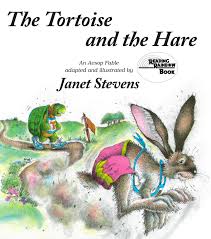World Turtle Day
Listen to the Recess! Clip
| Author | Rita Smith |
| Air Date | 5/22/2002 |

World Turtle Day Transcript
Today, in honor of National Turtle Day, I’m going to celebrate the turtle who has been held up to children for centuries as a role model of persistence, diligence, and stick-to-it-tiveness; the slow and steady tortoise in the fable, “The Hare and the Tortoise.”
I recently read several versions of this fable dating from 1752 to 1999. In some versions the hare challenges the tortoise, but in most of them the tortoise, weary of the hare’s insults and boasting attitude, challenges the hare to a race.
The hare always starts off fast and disappears before the tortoise has hardly taken a step. Confident of victory, he becomes bored, or finds something to distract him: juicy carrots in a garden or a few friends playing games in a nearby meadow. (4) The hare eventually decides to take a nap on a tuft of soft grass, giving the tortoise the opportunity to pass him by and beat him to the finish line.
And then, of course, there is the moral to the story. In the earlier versions it is almost always, Slow and steady wins the race. Later versions have variations on this theme: From a 1782 version comes this moral: Industry and application make amends for the want of a quick and ready wit. This is from a mid 19th century volume: The race is not always to the swift. Other variations include: The more haste, the worse speed; Persistence beast impulse; and Up and be doing. Here is an interesting moral from a 1916 version: Do your sleeping at night, not in the middle of the day. I like this variation on the original moral from a book published in the 1960’s: Slow and steady often wins the race. Very sixties, I’d say, with a bit of hedging and doubt creeping into the traditional moral philosophy. Slow and steady often wins the race, but not always. I admire the slow and steady, whether they be tortoises, children or adults, because, I, I admit, am like the hare, easily distracted from the distant goal by food, sport or a soft pillow. I believe hares also have much to offer the world, but today, on National Turtle Day, I toast all the tortoises and all the people who get so much accomplished by keeping their eye on the prize and exhibiting a single-mindness and perseverance that is truly praise-worthy.
Sources:
Aesop’s Fables, a new edition with proverbs and applications. London: Bliss, Sands & Co., 1897.
Aesop’s Fables, with 100 illustrations by F. Opper. Philadelphia: J.B. Lippincott Company, 1916.
Baby’s Own Aesop being the fables condensed in rhyme, with portable morals pictorially pointed by Walter Crane. London and New York: Goerge Routledge & Sons, 1887.
Bennett’s fables from Aesop and Others, translated into human nature by Charles H. Bennett. New York: Viking Press 1978, a reprint of the 1847 edition published by W. Kent, London.
The Fables of Aesop, translated into English by Samuel Croxall, with new applications, morals &c. by the Rev. George Fyler Townsend. London: Frederick Warne and Co., ca.1875.
Fables of Aesop and others, translated into English with instructive applications and a print before eadch fable. By Samuel Croxall. 12th ed. London: W. Strahan, J. F. and C. Rivington et.al, 1782
The Hare and the Tortoise, pictures by Paul Galdone. New York: Whittlesey House, McGraw Hill Book Company, c1962.